Malaysia’s Clinical Research Ecosystem
Applied Clinical Trials
Examining the role of Clinical Research Malaysia in advancing industry-sponsored drug development in the country.

The impact of globalization resulted in the shift of industry-sponsored clinical research (ISR) from high economic countries to Eastern European, Latin American and Asian countries. Since 2008, Asia has shown significant growth in interventional studies with an average of 8% growth. Asian countries offer two main benefits for conducting clinical trials: their large and diverse patient pools, and the relatively lower cost of clinical trial conduct. Malaysia, in particular, has many inherent qualities that make it an ideal country for conducting clinical trials. Those include a multi-ethnic population, which is relatively treatment naïve, competitive costs and an established healthcare infrastructure. Additionally, for over 20 years, Malaysia has had existing experience, facilities, processes, regulations and manpower in conducting clinical trials. The current Malaysian Economic Transformation Program (ETP) targets clinical research as one of its main drivers in economic growth. Therefore, the government of Malaysia, with an aim to promote and increase the number of clinical studies in the country, established Clinical Research Malaysia (CRM) in 2012 with the objectives of effectively increasing the speed, reliability and delivery of outcomes for all stakeholders involved. This review outlines the role of CRM, its achievements, future endeavors and the opportunities it provides for sponsors to carry out clinical trials in Malaysia.
Asia’s clinical development rise
Traditionally, industry-sponsored research has been conducted in high-income countries in Europe and in the U.S. due to the established research infrastructure and presence of major pharmaceutical companies in these countries.1 However, globalization resulted in shifting this research outside high income countries. The major beneficiaries of this shift have been Eastern European, Latin American and Asian countries. This change in the clinical research landscape has substantially increased the number of registered clinical trials globally, as evidenced by two separate studies analyzing the number of clinical trial registrations based on various global clinical trial registries. Viergever and Li analyzed the number of registered clinical trials in the International Clinical Trial Registry Platform (ICTRP), which was established by the World Health Organization (WHO) in 2006. The database was mined to include all studies registered up to December 31, 2013. After excluding all observational studies, a total of 186,523 clinical trials from 16 clinical study registries were included in the analysis. The number of registered clinical trials showed a substantial increase, constituting a seven-fold rise between 2004-2013.2 In another study conducted by Yathindranath et al, 15 online databases that contained registration for clinical trials globally were used, along with clinical trial registries in Asia. In Asia-Pacific, clinical trial volumes have been steadily growing from 5.9% of the total global volume in 2005–2007 to 9.7% in 2011.3 This shows that during these time periods, this region has become an important one for the clinical trial industry.
Asia, specifically, has shown significant growth in registered interventional clinical studies from 2008–2012, with an average growth rate of 8%,4 while North America showed a decline of 2% during the same time frame.4 Sixty percent of the world population reside in Asia.5 Therefore, as potential clinical trial hubs, Asian countries offer large and genetically diverse patient pools that are mostly treatment naïve, and a lower cost in conducting clinical trials in the face of limited patient pools and rising costs in the U.S. and Europe. Countries in Asia also offer varying disease epidemiology5 in both infectious and chronic diseases. This is reflected in the rise of lifestyle diseases such as diabetes, obesity, hypertension and various cancers due to urbanization.3 Factors such as government interest in expanding clinical research, large hospital infrastructures and an increasing number of clinical researchers, growth in the pharmaceutical sector and an increase in investment in research and development by pharmaceutical companies also contribute to Asia being an attractive destination to conduct these studies.3,5
Malaysian initiatives
The government of Malaysia, with an aim to provide sustained growth in various economic sectors, initiated the ETP, which comprises 12 National Key Economic Areas (NKEA). Clinical research is listed under the Healthcare NKEA, the second among the Entry Point Projects. Through this project, the Malaysian government intends to promote clinical research in the country and aims to increase the number of clinical trials from about 200 per year to at least 1,000 new and ongoing studies by 2020.6
Malaysia comprises 13 states: 11 in Peninsular Malaysia and two, Sabah and Sarawak, in the northern part of Borneo Island.7 Peninsular Malaysia is neighbored by Singapore in the south and Thailand to the north.
The Ministry of Tourism tagline for Malaysia, “Malaysia truly Asia,” depicts the diversity of races in this culturally rich land. The population estimates for 2016 stood at 31.7 million people (107 males per 100 females), out of which 89.7% are Malaysian citizens. Three major races and a minority of other races make up the Malaysian population (68.7% Bumiputera, consisting mainly of the Malay race; 23.4% Chinese; 7.0% Indians; and 1% other races).8 The median age is 28 years and the largest age group, between 15-64 years, makes up 69.4% of the population. The proportion of the elderly is also increasing due to better access to healthcare. Malaysia has a growing urban population. In 2016, it was estimated at 75% of the total population (compared to 57% in the East Asia and Pacific region).9
Malaysian healthcare system
The healthcare system in Malaysia is two-pronged with a major contribution from the public health sector. Both public and private healthcare systems are closely monitored by the government under the Ministry of Health, and share a similar system that offers primary health and specialist care. The public health system is far-reaching, with presence in the rural and urban settings, while private healthcare is mainly found in the urban areas.
Malaysia’s public health system is based on the WHO’s district health system model.10 The larger district health clinics are managed by family medicine specialists and are self-contained with their own basic laboratories, x-ray and ultrasound facilities. These district health clinics are capable of attending to both acute surgical and medical cases, as well as patients with stable chronic diseases, and providing maternal and child healthcare services. The smaller community clinics that are under the purview of these district health clinics are most often run exclusively by registered nurses and midwives who are trained to provide preventive maternal and child services, including home visits.10
Primary care in the private healthcare system is provided by privately-owned general practice (GP) clinics, stand-alone specialist clinics and outpatient specialist clinics in private hospitals. In 2008, there were an estimated 6,000 to 7,000 GP clinics and for every 10 primary care visits, six were to GP clinics. Some GP clinics, especially those that belong to a group practice, have added facilities such as portable blood analyzers, x-ray and ultrasound services.11 GP clinics like the district health and community clinics are located in both urban and rural areas of the country.
In 2013, 40.2% of all hospitals in Malaysia (N=351) were categorized as public hospitals (this included Ministry of Health hospitals, university hospitals and Ministry of Defense hospitals) while 59.8% were private hospitals.12 About 47.5% and 67.1% of the public and private hospitals, respectively, provide specialist services. Data from 2011 show an increasing trend in specialist care. For example, from 2010 to 2011, there were three additional hospitals providing oncology services (a total of 58 hospitals in 2011), and 10 new hospitals started providing psychiatric care during the same time frame (a total of 94 hospitals in 2011).
Malaysia’s clinical research ecosystem
In recent years, Malaysia has been striving to utilize the opportunities created due to the shifting of pharmaceutical clinical trial bases to Asia. Malaysia has inherent benefits to conducting clinical trials, such as its large multi-ethnic population that offers genetic diversity, established and good public and private healthcare systems, a consistently increasing number of good clinical practice (GCP)-trained and compliant investigators and support staff, an established and comprehensive ethical review process by ethics committees, adherence to intellectual property rights and competitive trial costs compared to other Asian countries. Malaysia also boasts shorter regulatory and ethics approval timelines for sponsored research that are comparable with countries like Hong Kong, Japan, Singapore, Taiwan and South Korea (see Table 1).13
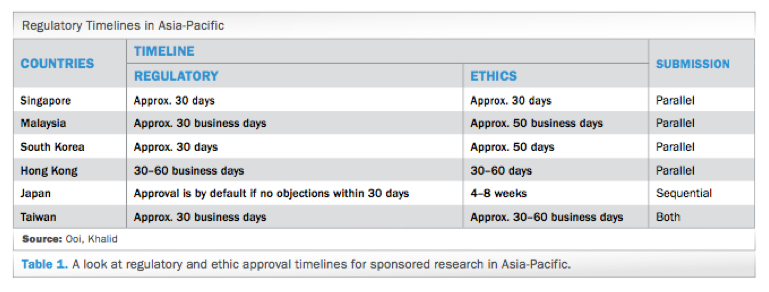
Generally, clinical research is conducted in Malaysia at university hospitals, Ministry of Health hospitals and increasingly at private medical centers across the country. The wide network of local Ministry of Health Health clinics represents a unique opportunity for access to a previously untapped, primary care patient pool.
The National Pharmaceutical Regulatory Agency (NPRA) ensures the quality, efficacy and safety of pharmaceuticals in Malaysia through the registration and licensing scheme. The NPRA acts as a secretariat to the Drug Control Authority (DCA).14 The DCA is empowered to review matters related to product registration, and approve or reject application for clinical trial import license (CTIL) or clinical trial exemption (CTX) among others. The institutional review board (IRB) structure in Malaysia depends on the location or type of facility conducting the research. Generally, most university hospitals have their own local IRB/independent ethics committee (IEC), while research conducted at Ministry of Health hospitals fall under the purview of the central IRB, which is the Medical Research and Ethics Committee (MREC).14
CTIL/CTX applications are submitted to the NPRA following the guidelines for CTIL/CTX. The NPRA screens the application dossier for completeness before handing them over to the DCA for a decision to be made. Once approval is granted by the DCA and MREC (or an other accepted IRB/IEC), the NPRA issues the CTIL/CTX and regulatory approval letters to begin the clinical trial (see Figure 1 below).15 Generally, a CTIL/CTX application is processed within 30 working days while the MREC approval takes 50 working days, if no amendments to the submitted documents are required. Both CTIL/CTX and MREC applications can be submitted in parallel. Users-the principal investigator (PI), contract research organization (CRO) and sponsor)-who intend to submit to MREC (or other accepted IRB/IEC) are required to register with the National Medical Research Register (NMRR) website and obtain a user account that can be used for all submissions thereafter.
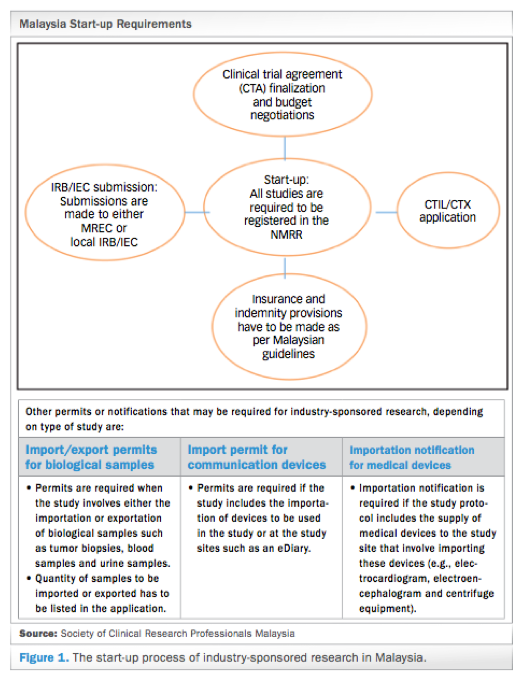
Clinical Research Malaysia
CRM is a non-profit company wholly owned by the Ministry of Health. The organization was established in June 2012 to position Malaysia as a preferred global destination for research and to function as an enabler and facilitator to the industry and medical fraternity for the conduct of clinical trials. CRM plays an important role in improving the local ecosystem to support growth in industry-sponsored research, facilitate the needs and requirements of industry players, grow the pool of capable investigators, support staff and trial sites and improve their capabilities and capacities to conduct this research. With the Ministry of Health’s support and clear knowledge of the local research environment, CRM is able to provide sponsors and CROs with a range of services that include complementary feasibility studies, investigator selection, placement and development of study coordinators, management of trial budget and review of clinical trial agreements.
Prior to CRM’s inception, there were several challenges in expanding clinical research in Malaysia. These hampered the operations of sponsored research in the country in terms of speed, reliability and delivery of favorable outcomes to the relevant stakeholders. The challenges included the time-consuming hiring process that involved government bureaucracy and acquisition of assets, poor transparency of fund management and lack of activities to increase the number of investigators and well-equipped trial sites for the conduct of clinical trials. There was also a need for a locally placed “one-stop” center to facilitate sponsors/CROs interested in
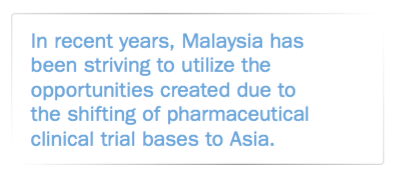
conducting clinical research in Malaysia, by championing collaborations with the regulatory agencies, customs officials and investment authorities. Furthermore, though the interest in clinical research among the existing investigators and support staff were high, there was no clear clinical research pathway to encourage and develop their potential in this area.
As part of Malaysia’s ETP, CRM was established to help ensure the reliability, speed and delivery of outcomes for all drug development stakeholders. These objectives include the improvement of clinical trial sites by addressing their needs and allocating highly trained study coordinators; increasing well-trained and GCP-compliant investigators through training and awareness campaigns; implementing strategies and procedures for feasibility assessments and investigator selection; providing transparent and efficient trial budget management; initiating collaborations with local, regional and global stakeholders; attracting global pharmaceutical and CRO investments; inspiring private hospitals and universities to be part of the expansion of the clinical trial environment; and investigating and addressing the perception and awareness of clinical trials among healthcare professionals, administrators, patients and the public.
Achievements of CRM
CRM has developed five key strategies to put in place a comprehensive, enabling and supportive ecosystem that meet the needs of industry players and the medical fraternity. The goals are to grow the pool of investigators and sites, attract new research to Malaysia, collaborate with stakeholders, create awareness of CRM and develop human capital.
CRM is entrusted to compile and track the number of sponsored trials from MREC and all IRB/IECs-and these numbers are reported annually to the Malaysian government. Between 2010 and 2015, Malaysia has seen a steady increase in this number, increasing from 143 trials to 201 (see Figure 2). There was no increase in the number of trials between 2014 and 2015. During this time period, a global decline (by 10%) in the number of sponsored studies was recorded.
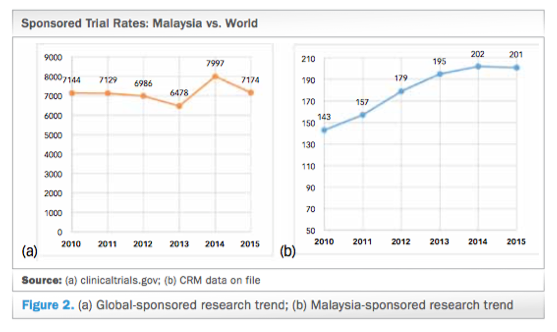
The number of sponsors and CROs who utilized CRM’s services, however, recorded a sharp increase in 2016 compared to 2014. As of September 2016, there was more than a 200% growth in the number of sponsors, while the number of CROs doubled during this time period, indicating the confidence of foreign investors in Malaysia’s capabilities (see Figure 3). In this same time frame, CRM’s experience as a site manager expanded to 25 therapeutic areas.
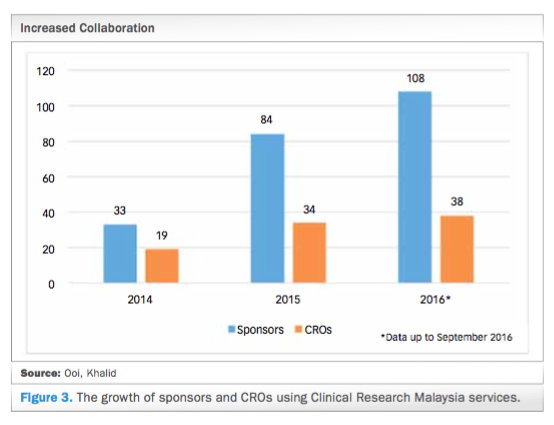
The gross national income (GNI) created by clinical trials in 2015 totaled over $28.01 million USD, an increase of $17.03 million USD from 2011. There was a growth in the number of PIs between January and September 2016 (see Figure 4) after the country recorded a sharp decline in 2015. One of the reasons for the decline was due to senior investigators retiring without proper succession planning.
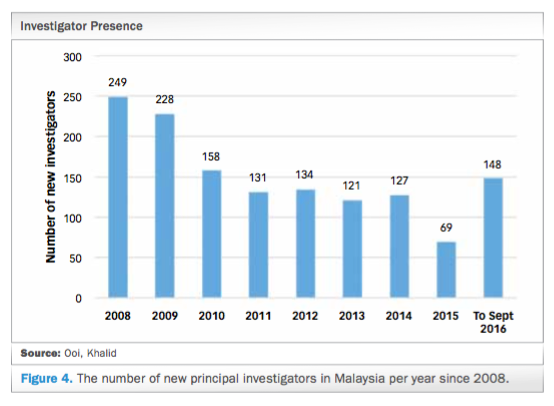
Additionally, there was lack of support in promoting industry-sponsored research to junior doctors during that time. In 2015, CRM actively took up this role to increase the number of investigators by supporting eight State Research Days, which saw an impressive 550 abstracts submitted from all over the country. State Research Day is an annual Ministry of Health initiative aimed at providing an avenue and opportunity to allied health and medical personnel to share their research findings. It’s also a platform to raise awareness on the importance of research in improving patient care in the country. Seeing its success, CRM committed to support 11 State Research Days in 2016.
In its infancy in 2012, CRM had 22 study coordinators that were placed throughout Malaysia at various sites conducting industry-sponsored research; this number has grown to 93 as of September 2016. CRM has expanded its operations beyond the realm of Ministry of Health sites, and has received requests to support investigators and sites in Ministry of Higher Education hospitals and private hospitals. In 2015, the strategies employed by CRM had created 1,118 high-skilled jobs in the clinical research industry in Malaysia, exceeding the 1,000 it was entrusted to create by 2020.
The various initiatives taken so far by CRM to improve Malaysia’s clinical research ecosystem include recruiting, training and developing medical officers into future investigators; investing in various clinical research sites by equipping them with the necessary infrastructure; shortening the clinical trial agreement (CTA) review and approval timeline from 14 working days to five working days; seconding staff to the MREC and the Medical Device Authority (MDA) to improve approval timelines and assist in queries from the industry; and forming partnerships with the media to create awareness of clinical trials. Furthermore, CRM organizes “Industry Dialogues” twice a year to understand and address issues being faced by the pharmaceutical, biotechnology and medical device industries, as well as CROs.
CRM is currently in collaboration with the Drugs for Neglected Disease initiative (DNDi), a not-for-profit R&D organization that works to deliver new treatments for neglected diseases. With this project, CRM plans to develop a public health approach to hepatitis C within the framework of the future “National Strategic Plan” on viral hepatitis. The immediate goal of the initiative is to conduct clinical studies of promising new treatment regimens for hepatitis C That will be followed by scale-up of treatment for patients, with the overall objective of ensuring equitable access to affordable and effective treatments for patients suffering from hepatitis C in Malaysia.
A scale-up of treatment is necessary in order to have an impact on the number of cases, which are steadily increasing. Due to this surge and the high prices of new hepatitis C medicines, it has been almost impossible for the Malaysian government to provide access to treatment at the necessary scale. The trials conducted with the support of DNDi are anticipated to introduce a new therapy as soon as possible and a scale-up to reach all patients in Malaysia.
Overall, the strategies initiated by CRM from its inception in 2012 have been very encouraging. the organization achieved 94% of its key performance index (KPI) 1 determined by the number of industry-sponsored trials conducted in Malaysia during 2015 (201 vs. goal of 214 despite a 10% global decline). Meanwhile, the number of clinical trials performed in Ministry of Health facilities (KPI 2; 128/120) during the same year achieved 107% of CRM’s KPI 2.
Future endeavors of CRM
The Ministry of Health through CRM is driving an initiative to prepare Malaysia to conduct Phase I clinical trials in the next three years. This initiative, termed the Phase I Realization Project (P1RP), was designed to involve the country in all phases of drug development. The five pillars that support the P1RP blueprint include the development of Phase I guidelines, people development, capability
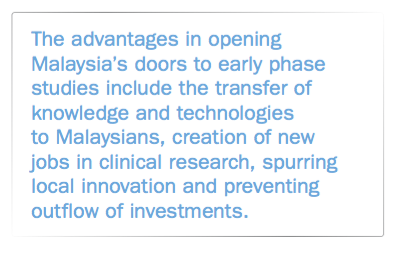
development, preparation of sites and risk management. The initiative, which started in May 2016, will see the completion of the Phase I clinical research ecosystem in 2019. The capture of Phase I trials may result in a spillover effect of more Phase II and III studies into Malaysia. Among the economic advantages in opening Malaysia’s doors to early phase studies include the transfer of knowledge and technologies to Malaysians, creation of new jobs in clinical research, spurring local innovation and preventing outflow of investments.
Conducting early phase studies in accordance with international regulatory standards would also drive capacity-building for local ethical review, facilitate healthcare infrastructure development, increase economic activity by encouraging research into more innovative products and reduce the culture of dependency on developed countries.
Conclusion
Established by the Malaysian Ministry of Health, CRM exists to advance global health solutions for a brighter and more hopeful future for patients by providing speedy and reliable end-to-end clinical research support for quality studies. CRM’s innate understanding of the local clinical research landscape, with international standards of operations coupled with fundamental backing of the government ministries, provides the group with an incomparable advantage in working with partners from the nascent stages of development to materialization of the end product-with the goal of delivering better treatments and more high-skilled job opportunities. It is the hope these efforts will help move Malaysia closer to being a globally preferred destination for clinical research.
A.J.A. Ooi is Senior Business Development Executive, Clinical Research Malaysia; K.F. Khalid, MD, is Head of Business Development, Clinical Research Malaysia; email: khairulfaizi@clinicalresearch.my* This research did not receive any specific grant from funding agencies in the public, commercial or not-for-profit sectors.
References
1. Murthy S, Mandl K. D, Bourgeois F. T. Industry-sponsored clinical research outside high-income countries: an empirical analysis of registered clinical trials from 2006 to 2013 // Health. Res. Policy. Syst, 2015;13:28, doi: 10.1186/s12961-015-0019-6
2. Viergever R. F, Li K. Trends in global clinical trial registration: an analysis of numbers of registered clinical trials in different parts of the world from 2004 to 2013 // BMJ Open, 2015; 5:e008932, doi: 10.1136/bmjopen-2015-008932
3. Yathindranath S, Kureishi A, Singh S, et al. Evolution of the clinical trial landscape in Asia Pacific // J Clin Trials, 2014;6:75-84
4. Korieth K, Anderson A. New growth and decline in Asia clinical trials // The CenterWatch Monthly, 2013;20:10
5. Rahman S, Majumder MAA. Managing clinical trials in Asia: issues, threats, opportunities and approaches // South East Asia Journal of Public Health, 2012;2(2):80-84
6. National Key Economic Areas. Healthcare NKEA fact sheet. http://etp.pemandu.gov.my/upload/NKEA_Factsheet_Healthcare.pdf. Accessed 07/10/16
7. Rosemawati A, Sallehudin AB. Cancer Registration in Malaysia Asian Pacific Journal of Cancer Prevention, 2001;2(IACR Supplement):43-45
8. Department of Statistics Malaysia. Press release: current population estimates, Malaysia, 2014-2016. 22 July 2016.
9. The World Bank. http://data.worldbank.org/indicator/SP.URB.TOTL.IN.ZS?locations=Z4-MY. Accessed 7/10/16
10. Yasin S, Chan CKY, Reidpath DD, Allotey P. Contextualizing chronicity: a perspective from Malaysia // Globalization and Health, 2012;8:4, doi: 10.1186/1744-8603-8-4
11. Aljunid S, Primary health care and health information needs in Malaysia. Presented at United Nations University-International Institute for Global Health. http://www.whofic-apn.com/pdf_files/4th_17_35p.pdf. Accessed 6/10/16
12. Clinical Research Centre. National Healthcare Statistics Initiative. http://www.crc.gov.my/nhsi/charts/malaysia.php. Accessed 07/10/16
13. pharmaphorum. Regulatory timelines in Asia-Pacific. http://pharmaphorum.com/views-and-analysis/regulatory-timelines-asia-pacific/. Accessed 11/10/16
14. Drug Control Authority, Ministry of Health. Terms of Reference. 2013
15. Society of Clinical Research Professionals Malaysia. A guide to conducting clinical trials in Malaysia. 2016
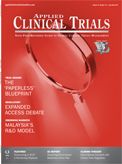
Improving Relationships and Diversifying the Site Selection Process
April 17th 2025In this episode of the Applied Clinical Trials Podcast, Liz Beatty, co-founder and chief strategy officer, Inato, discusses a number of topics around site engagement including community-based sites, the role of technology in improving site/sponsor relationships, how increased operational costs are impacting the industry, and more.
Behind the Buzz: Why Clinical Research Leaders Flock to SCOPE Summit
February 7th 2025In this episode, we meet with Micah Lieberman, Executive Conference Director for SCOPE Summit (Summit for Clinical Ops Executives) at Cambridge Innovation Institute. We will dive deep into the critical role of collaboration within the clinical research ecosystem. How do we bring together diverse stakeholders—sponsors, CROs, clinical trial tech innovators, suppliers, patients, sites, advocacy organizations, investors, and non-profits—to share best practices in trial design, program planning, innovation, and clinical operations? We’ll explore why it’s vital for thought leaders to step beyond their own organizations and learn from others, exchanging ideas that drive advancements in clinical research. Additionally, we’ll discuss the pivotal role of scientific conferences like SCOPE Summit in fostering these essential connections and collaborations, helping shape the future of clinical trials. Join us as we uncover how collective wisdom and cross-industry partnerships are transforming the landscape of clinical research.
FDA-Approved Gene Therapy Beqvez Shows Sustained Efficacy, Safety in Long-Term Hemophilia B Trial
April 17th 2025Beqvez (fidanacogene elaparvovec), an FDA-approved one-time gene therapy for hemophilia B, demonstrated sustained factor IX expression, low bleeding rates, and a favorable safety profile over long-term follow-up.